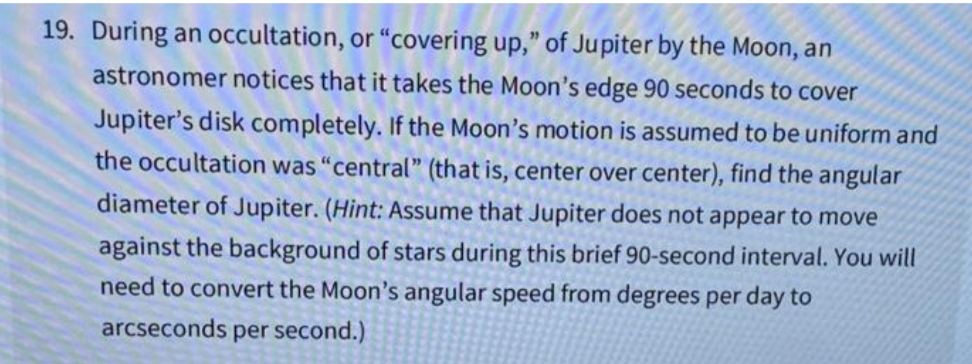19. During an occultation, or “covering up," of Jupiter by the Moon, an astronomer notices that it takes the Moon's edge 90 seconds to cover Jupiter's disk completely. If the Moon's motion is assumed to be uniform and the occultation was "central" (that is, center over center), find the angular diameter of Jupiter. (Hint: Assume that Jupiter does not appear to move against the background of stars during this brief 90-second interval. You will need to convert the Moon's angular speed from degrees per day to arcseconds per second.)
19. During an occultation, or “covering up," of Jupiter by the Moon, an astronomer notices that it takes the Moon's edge 90 seconds to cover Jupiter's disk completely. If the Moon's motion is assumed to be uniform and the occultation was "central" (that is, center over center), find the angular diameter of Jupiter. (Hint: Assume that Jupiter does not appear to move against the background of stars during this brief 90-second interval. You will need to convert the Moon's angular speed from degrees per day to arcseconds per second.)
Related questions
Question
6

Transcribed Image Text:19. During an occultation, or "covering up," of Jupiter by the Moon, an
astronomer notices that it takes the Moon's edge 90 seconds to cover
Jupiter's disk completely. If the Moon's motion is assumed to be uniform and
the occultation was "central" (that is, center over center), find the angular
diameter of Jupiter. (Hint: Assume that Jupiter does not appear to move
against the background of stars during this brief 90-second interval. You will
need to convert the Moon's angular speed from degrees per day to
arcseconds
sper second.)
Expert Solution
This question has been solved!
Explore an expertly crafted, step-by-step solution for a thorough understanding of key concepts.
This is a popular solution!
Trending now
This is a popular solution!
Step by step
Solved in 2 steps with 1 images
